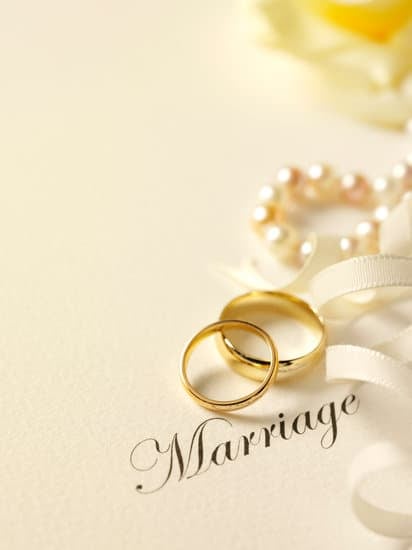When it comes to the question of whether the wedding band goes before or after the engagement ring, there are various factors to consider. The significance of these two pieces of jewelry in the wedding tradition plays a key role in determining their order of placement on the finger. From cultural importance to personal preferences, there are several aspects that come into play when making this decision.
The wedding band and engagement ring hold a deep symbolic meaning and historical significance in weddings. Both rings are a representation of love, commitment, and unity between two individuals. The wedding band, typically exchanged during the marriage ceremony, symbolizes eternal love and devotion, while the engagement ring signifies a promise and intention to marry. Understanding the symbolism behind these rings provides insight into their placement on the finger.
In this article, we will delve into the meaning behind the wedding band and explore its historical roots. We will also examine the significance of the engagement ring, considering its origins and cultural importance. By understanding the traditional and modern perspectives on wearing these rings, you can gain valuable insights into deciding whether the wedding band should go before or after the engagement ring.
The Meaning Behind the Wedding Band
The wedding band, also known as the wedding ring, holds deep symbolism and rich history in the tradition of marriage. For centuries, the circular shape of the wedding band has been associated with eternal love and commitment. The unbroken circle represents an unending bond between two individuals, making it a powerful symbol of marriage.
Symbolism of the Wedding Band
The tradition of exchanging rings dates back to ancient Egypt, where the circle was a symbol of eternity. The use of precious metals such as gold in wedding bands symbolized wealth and prosperity for the couple.
In Christian ceremonies, the circular shape is believed to represent God’s unending love and faithfulness. Additionally, the placement of the ring on the fourth finger of the left hand is based on the belief that this finger contains a vein that leads directly to the heart.
Historical Significance
The practice of exchanging rings as a symbol of commitment can be traced back to ancient Rome, where wives were given two rings: one made of gold to wear in public and another made of iron to wear at home while doing household chores. In medieval Europe, rings were engraved with romantic sentiments or even used as a form of signature for those who could not read or write.
As time passed, these traditions evolved into modern customs surrounding the exchange of wedding bands during marriage ceremonies.
The significance behind wearing a wedding band goes beyond just an accessory; it represents love, commitment, and unity between partners. Understanding its deep symbolism can influence an individual’s decision on whether to wear their wedding band before or after their engagement ring.
The Significance of the Engagement Ring
The history of the engagement ring dates back to ancient times, with the tradition believed to have originated from the Roman custom of giving a betrothal ring as a sign of commitment. The significance of the engagement ring lies in its symbolism of love, devotion, and intention to marry.
In many cultures, the exchange of rings during an engagement ceremony symbolizes a formal agreement to enter into marriage. The circular shape of the ring represents eternity and the unending bond between two people.
In addition to its symbolic meaning, the engagement ring also holds cultural importance in various societies around the world. In Western cultures, it is customary for a man to present his partner with an engagement ring as a token of his affection and commitment. The act of proposing with a ring has become a romantic tradition that marks the beginning of an exciting journey towards marriage.
Furthermore, the type and style of the engagement ring can also reflect cultural influences and personal preferences. For example, in some regions, certain gemstones or precious metals are traditionally used in engagement rings to symbolize specific qualities or values. Whether it’s a classic diamond solitaire or a unique colored gemstone, the choice of an engagement ring often reflects individual tastes and cultural traditions.
- The circular shape representing eternity
- Symbolism of love, devotion, and intention to marry
- Cultural importance in various societies
Which Comes First
The traditional placement of the wedding band and engagement ring has been a topic of debate for many soon-to-be-married couples. There are various factors to consider when deciding whether the wedding band goes before or after the engagement ring, including both historical customs and personal preferences.
Historical Customs
For centuries, it has been customary to wear the engagement ring closer to the heart, which traditionally meant placing it on the ring finger of the left hand. The wedding band would then be worn on the same finger, closer to the fingertips. This order symbolizes the progression from engagement to marriage and was believed to have originated from ancient Egyptian and Roman traditions.
Symbolism and Meaning
The positioning of the rings holds symbolic significance as well. The engagement ring represents a promise of commitment and eternal love, given as a tangible sign of betrothal. On the other hand, the wedding band symbolizes an unbroken circle, representing eternity and everlasting love in marriage.
Modern Adaptations
In modern times, there has been a shift towards personalized interpretations of tradition. Some couples choose to follow historical customs while others opt to reverse the order out of personal preference or practical considerations. Additionally, some individuals even choose to wear their engagement ring on their right hand after getting married as a way to maintain its significance while making room for their wedding band on their left hand.
There are no strict rules when it comes to determining whether a wedding band should go before or after an engagement ring, leaving room for each person’s interpretation and expression of their unique love story. Ultimately, this decision is a personal one that can be influenced by history, symbolism, modern trends, personal preferences, and practical considerations.
Modern Trends
When it comes to the order in which to wear your wedding band and engagement ring, modern trends offer a range of options that cater to individual preferences and styles. Some contemporary couples are choosing to forgo tradition altogether and opt for creative ways of wearing their rings that reflect their unique bond. Here are some modern trends and preferences for wearing the wedding band and engagement ring:
- Stacking: One popular trend among modern couples is stacking the wedding band and engagement ring on the same finger. This can create a stylish and cohesive look, with the two rings complementing each other. Whether the engagement ring is placed on top of the wedding band or vice versa is entirely up to personal preference.
- Wearing on Different Hands: Another modern option is to wear the wedding band on one hand and the engagement ring on the other. This choice allows each ring to stand out on its own while still symbolizing unity and commitment.
- Customized Designs: Many couples are opting for customized designs that incorporate both the wedding band and engagement ring into a single cohesive piece. This can include unique shapes, gemstone arrangements, or personalized engravings that symbolize the couple’s love story.
These modern trends allow couples to express their individuality while still honoring the tradition of wearing both a wedding band and an engagement ring. Ultimately, there are no hard-and-fast rules when it comes to how these rings should be worn, allowing for greater versatility and creativity in expressing one’s love and commitment.
In addition to these modern options, some practical considerations may also influence how a couple chooses to wear their rings. Factors such as comfort, lifestyle, work requirements, and personal style can all play a role in determining whether the wedding band goes before or after the engagement ring. It’s important for couples to consider these practical aspects alongside their personal preferences when deciding on the order in which they choose to wear their rings.
Personal Preferences
When it comes to the placement of the wedding band and engagement ring, personal preferences play a significant role. There are a variety of factors that can influence an individual’s choice in wearing their wedding band and engagement ring in a certain order. One of the main considerations is the significance attached to each ring. The engagement ring is often seen as a symbol of commitment and love, while the wedding band represents the union and partnership of marriage.
Another factor that may influence the decision on which ring to wear first is cultural traditions. In some cultures, there are specific customs and beliefs regarding the placement of the wedding band and engagement ring. For example, in some countries, it is customary for the wedding band to be worn closer to the heart, while in others, it is more common for the engagement ring to be placed first on the finger.
Additionally, practical considerations such as comfort, lifestyle, and style can also impact an individual’s choice. Some people may find it more comfortable to wear their wedding band first because of its simpler design, while others may choose to place their engagement ring on first due to its more ornate or intricate details.
These various factors demonstrate that there is no one-size-fits-all answer to whether the wedding band goes before or after the engagement ring. Ultimately, it is important for individuals to consider their own values, cultural background, comfort level, and personal style when making this decision.
| Factors | Influence |
|---|---|
| Significance of rings | Determines sentimental value |
| Cultural traditions | Affects traditional placement |
| Practical considerations | Can impact comfort and lifestyle |
Practical Considerations
When it comes to deciding whether the wedding band goes before or after the engagement ring, practical considerations play a significant role. Comfort is an essential factor to keep in mind.
Some people find that wearing their wedding band closer to their wrist feels more comfortable, while others prefer having it next to their engagement ring for various reasons related to comfort. It’s important to try out different combinations and observe how each one feels throughout the day in order to determine which placement offers the most comfort for you.
Another practical aspect to consider is style. Some individuals may have a specific aesthetic in mind that calls for wearing the wedding band before or after the engagement ring. For example, if both rings are designed to fit together seamlessly, wearing the wedding band first might be the best option. Conversely, some people may prefer to showcase their engagement ring prominently by having it closer to their hand when worn with the wedding band.
Lifestyle also plays a crucial role in this decision-making process. For individuals with more hands-on or physically demanding jobs, wearing the wedding band before the engagement ring might provide greater protection for both rings. On the other hand, some may find it easier to wear their engagement ring first as they can enjoy showcasing this special piece of jewelry without any obstructions from a wedding band.
| Practical Aspect | Consideration |
|---|---|
| Comfort | Determining which placement offers the most comfort |
| Style | Aesthetic preferences and design compatibility of both rings |
| Lifestyle | Protection and ease of wearing based on daily activities and work |
Conclusion
In conclusion, the decision of whether the wedding band goes before or after the engagement ring is ultimately a personal one. Both the wedding band and the engagement ring hold deep significance and symbolism in the tradition of marriage, with the wedding band representing eternal love and commitment, while the engagement ring symbolizes the promise of future union.
The historical and cultural roots of wearing these rings in a specific order may influence some individuals, but modern trends and individual preferences also play a significant role.
While tradition dictates that the engagement ring is worn first, followed by the wedding band, many couples nowadays choose to wear their wedding bands alone or opt for more modern and unique ways of combining and wearing both rings. Personal preferences, practical considerations such as comfort and lifestyle, as well as cultural influences all contribute to an individual’s decision on how to wear these important symbols of love.
Ultimately, what matters most is the significance that each person attributes to these meaningful pieces of jewelry. Whether it’s following tradition or creating a new custom, what’s essential is that wearing both rings represents a couple’s commitment to one another. The symbolism behind the rings will remain constant regardless of which one comes first – it’s the love and devotion they represent that truly matters.
Frequently Asked Questions
Which Goes First Engagement and Wedding Ring?
Traditionally, the engagement ring is worn first, followed by the wedding ring. The idea is that the engagement ring should be closer to your heart, and then the wedding ring is placed on top of it during the ceremony.
Do You Wear Your Wedding Band on Top or Bottom?
The wedding band is typically worn on the bottom, closer to your palm. This allows for the engagement ring to be worn on top, symbolizing its priority as the initial promise of marriage before the wedding took place.
Do You Wear the Engagement Ring Before Marriage?
Yes, it is common to wear the engagement ring before marriage. The engagement ring symbolizes a commitment to getting married in the future, while the wedding ring signifies that two people are officially married. As a result, many people wear their engagement rings from the time they are engaged until well after their wedding.

I have been involved in marriages for over 20 years helping couples and singles understand more about them.





